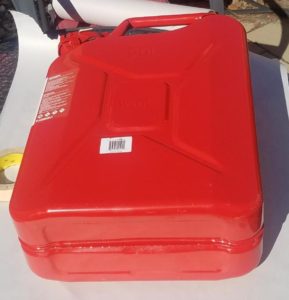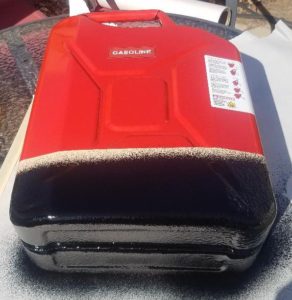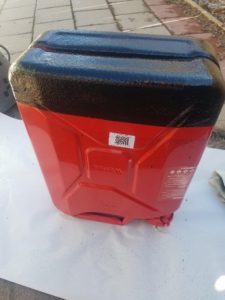This is turning into quite the series of posts, isn’t it? I’d mentioned that I’d used a spray-coating on the bottom of my gas cans in order to protect the base of the cans from paint-removing scrapes and the resultant rust that would occur. I had done this before the arrival of Flex Seal which is, basically, spray on rubber coating. Seemed logical to go ahead and try it out on the new cans.
So, we take a new can and do a poor job of taping off the edge of where we want to spray:

 Hit it with a goodly amount of FlexSeal and let it dry:
Hit it with a goodly amount of FlexSeal and let it dry:
Seems to be just what the doctor ordered.


Another place to put a tripe of that stuff would be where the can bulges out the most on its sides. Fill the can and put it up against something vertical to see where the can touches it, and spray a stripe accordingly. This will keep the paint from being scuffed away there.
Tom:
I Hope you meant “Stripe” not “Tripe” for your cans, because I’ve never heard of raw Chittlin’s being used to waterproof things!
So much for spellcheck…
I was looking as some new cans in the local farm supply store yesterday that looked just like those. But I could not find any labeling anywhere to say where or who manufactured them. The were going for $50 each, and I suspect they were chinesium clones of the real thing. If I can find, or justify ordering the ones your previous posts recommended, I will definitely try that treatment.
My old jerry cans are beat up and rusty, but still doing the job–I keep them stored in a cool and dry shed, on pallets off the concrete; recycle the gas at least once a year (usually twice) with stabilizer. I had a hard time finding metal flex spouts for them until I found some at a mil-surplus outfit, so I snagged the three they had. New rubber gaskets were also hard to find, and expensive when I did, but the old ones were crumbling and useless.
What gummint regulation did to the gas can is a travesty, but that’s a rant for another time.
Know that on Recreational Vehicle boards, FlexSeal is a dirty word. Everyone is in agreement that it will deteriorate and leak in 6 months or so. The use for them is mostly on roofs of travel trailers, i believe. Itll be interesting to see how it holds up for you in that use.
Bedliner, heavily sprayed, might be another option to try.
That is what I use on my metal cans- bedliner. IMO it holds up to more movement/friction. It is made for “abuse” in a sense.
+1 on Rhino bedliner
Interesting that you have to jump through these hoops with gas cans that cost as much as these do. Several years ago I bought several sceptre military issue gas cans from Princess Auto* and never had any problems.
https://www.princessauto.com/en/20-litre-green-military-style-fuel-can/product/PA0008451411
Umm, those linked cans cost the same. And why wouldn’t you want to take care of something that is expensive (for what it is) and a critical prep?
Those cans never rust? The paint doesn’t chip?
I’m 60 miles from the coast and everything I own rusts if not taken care of.
n
“Military style.”
And those aren’t even the mil-spec Sceptre cans….The miliatary version are twice as thick or more
These Princess Auto cans cost $90, have no spout, and are plastic. Doesn’t seem a fair comparison to these NATO metal cans.
A few years ago I had several plastic 5 gal cans stored in my shed, squirels got in and ate holes in the top of 2 gas and 1 kerosene can. Seems that the plastic was made with corn oil instead of regular oil. I have since switched all of them to metal.
It’s the vegetable oil based release agent for the mold. There were some autos ( toyota I think) that were plagued with rodents chewing up wiring for the same reason.
CZ,
You may recall that when you published your initial article about the Wavian gas cans, I sent this link for used NATO cans at Sportsman’s Guide.https://www.sportsmansguide.com/product/index/nato-military-surplus-20l-steel-jerry-can-used?a=2049570 I ordered three of the cans that day. The total cost was $67.47 (including tax, but with free shipping because of my annual membership there)
The cans arrived a half-hour. They are in better condition than the one shown on the web site. The interiors are pristine. Alas, they are out of stock now.
During the run up to Y2K, I bought six that were more blemished than the Sportsman’s Guide cans. They still do the job. In any event, I am going to be inspecting the spout gaskets to determine if any of them need to be replaced. I recently purchased replacement gaskets on eBay for both the NATO cans and the G.I. cans I have. Proper sealage is extremely important to longer fuel life.
I have a ’46 Willys and carry fuel cans on it. I wanted to avoid using non-period fuel cans on it. Genuine old G.I. cans are hard to come by. I came across a couple of cans that had rust on the inside. Not wanting to have flakes of rust being sucked into the fuel line, I bought bottles of motorcycle fuel tank liner. The product comes in two parts that are then mixed and poured into the fuel can. By rotating the can in every direction, the inside of the can is lined with a coating that hardens as a barrier on the inside of the can.
The original tank liner/sealer was Kreem. Works well, but not cheap.
You can also buy a roll of gasket material and cut out your own gaskets! Lots of hardware stores stock the stuff. Just be sure it’s rated for fuels or other solvents.
You can also paint over the flexseal afterwards.
Damn it, man. Now I got the ‘survivalist envy’ agin.
seems to me if i remember rightly from about a hundred years ago that the OLD STYLE canning gaskets the ones with glass lids are the right size for the lids on these gas cans. still available up here in the great still WHITE north country. think they are VICTORY brand maybe. CHEERS
Dan, can you clarify what you meant by “OLD STYLE canning gaskets the ones with glass lids”? Are you talking about pressure cooker gaskets, canning jar gaskets, or what? Both of those gaskets are circular and the gasket for these cans appears to be rectangular. What am I misunderstanding?
I am nobody’s expert concerning these gaskets, but are the canning gaskets vulnerable to deterioration from contact with petroleum products?
Coating the bottom to eliminate corrosion may be
a good thing to do, but…what about being able to
ground the container, while filling, to prevent static
sparking ?
Hmmm. And I was just about to spray my cans with pickup bed liner.
Ever seen a spark while fueling? Do you think the plastic cans are grounding to the concrete at the station? Do you ground yourself prior to fueling your vehicle?
If you’re worried, hold the metal can with one hand, touch the metal frame of the pump with the other. Pick up the spout and fuel normally. Seriously, this will discharge any static buildup at the pump, where it is safe.
I had the costco attendant scold me about my plastic cans in the METAL bed of my truck (the warnings are about PLASTIC bed liners) IN THE RAIN. You can’t get static sparks in the rain.
n
“Do you ground yourself prior to fueling your vehicle?”
Costco pumps here include a sticker with instructions for those pumping gas to touch the metal sode of their car before pumping gas.
If I am reading that sticker correctly, the instructions state “to prevent sparks from the gas tank, touch outside of vehicle before removing gas cap.” The reason is to ground the vehicle before fueling, not the pump, which is grounded.
Of course, my understanding of the engrish language may be lacking.
Um, Nick…?
“You can’t get static sparks in the rain.”
Sorry to bother you, really, but Physics would like to have a word with you…
https://i.imgur.com/Vx63zBb.jpg
___
If anyone is worried about grounding cans, get a couple of battery clamps and a short length of copper cable. Put it with the fuel spout. I recommend using a repurposed small mesh laundry bag.
Yes well, GOD can get static sparks in the rain, you and I can’t. :-p The moisture in the air and on surfaces dissipates any static charge that might build on the insulator (like you or the PLASTIC can or PLASTIC bedliner. )
In any case, if someone is worried, hold (or touch) the can while then touching the metal (and grounded) pump will provide a path to discharge any static, well away from the can and any vapors.
n
(and like most things that look simple initially, static dissipation and fueling has much more to it, if both the source and the destination for the fuel are mobile (and not grounded) hence the grounding wire for airplane fuel trucks, and mobile fuel transfer tanks)
From the googles for anyone who isn’t tired from whuppin’ on this dead equine…
“Humidification is a very effective way to eliminate the build-up of static electricity in manufacturing environments. By keeping the humidity at 55%RH the moisture content of the air is a natural conductor and earths any potential static charge.”
and
“At what humidity level does static electricity occur?
The relative humidity must be below 40 percent in order for a static charge to be produced. 40 to 60 percent will still enable for build-up, but at a significantly reduced level due to the fact that the static leaks to the ground through the air.”
I’ve yet to be in the rain where the RH was below 40%….
MIKE: re the old style canning jars, they had a metal bail on the jar that flipped up or down to clamp the glass lid on during the canning process. wife still uses them the odd time, the lids themselves had an imbossed cross on them that the wire bail set into. this goes back to 73 & the EMBARGO when everybody & their dog was grabbing gas cans & ww2 cans were all the rage. i never liked the jerry cans much the damn things weren’t vented so it took all day to mt them & they always wanted to leak. ordered half a doz.from jc whitney & co. round ones w/ vent & guess what jc went tits up & no cans. pissed me off biggly, SO since their catalogs were free & there was a postage paid order form inside each catalog good ole jc, got a metric shit ton of bricks mailed to them from all over the country, i was long hauling at the time. wonder if they got the message? meanwhile the rubber gaskets for the lids are still available up here in canada, they would probably degrade over time tho but best we can do now. i’ve had good luck storing gas with an additive of av gas to regular gas if you have an airport nearby. i dump 5 gallons into my 100 gallon tank & it seems to keep forever. av gas twice as expensive per liter but much higher octane, lotsa hotrod snomobilers use it up here. yeah i know it’s leaded but who gives a shit in the shtf .makes chainsaws & lawnmowers sit up & take notice.
MIKE: as an addendum i have no clue what new can spouts look like, if they are rectangular or not, haven’t checked out cans since forever, sorry to veer off course tend to do that a lot lately, but only online not on the highway !! the gaskets i was talking about are jar gaskets. used for pressure canning & water bath also i guess all we ever do is pressure canning tho.hope this clears things up a bit.
The problem with rubber and plastic stuff is volatile organic compounds. Some of which is residual. I just wouldn’t trust a rubber coat not to affect the underlying plastic of the can. Causing ruptures or cracks.
Shouldnt be an issue on metal cans.
I can’t afford to drop much on new cans, but I ordered a couple of the ‘long-stored/never-used’ from Coleman’s (https://colemans.com/nato-military-jerry-can#). I figure I have rust-preventive paint and wire brushes aplenty, so elbow grease and time are worth the cost savings for now.
I can only speak concerning the three cans I bought from Sportsman’s Guide, but they were in much better condition than the ones shown in the Coleman’s ad, and they were even better than the ones shown on the Sportsman’s Guide web site.
I used a little steel wool, sandpaper, and spray paint on them and, voilà!, they appeared to be almost new.
The reviews on Coleman’s mostly say the same. I will say anything I’ve ordered from them in the past normally looks better than the pictures suggest.
https://www.tiktok.com/@thanhluandang/video/6940977743454539009
soap
I have a couple of these (gas/diesel) for the house.
https://www.amazon.com/SUNCOO-Gallon-Portable-Storage-Generators/dp/B082WHTJNP/ref=sr_1_9?dchild=1&keywords=fuel+caddy&qid=1616084613&sr=8-9
Sportsman’s Guide has surplus NATO jerry cans back in stock: https://www.sportsmansguide.com/product/index/nato-military-surplus-20l-steel-jerry-can-used?a=2217325&_br_psugg_q=nato%20jerry%20can
Again, the three cans I ordered had minor rust and scrapes that were cleaned up with a little sandpaper and steel wool on the exteriors. The interiors were pristine. A coat of spray paint later and they looked new. YMMV.
Ok CZ,
I hesitated to even post this, lest they become unobtainium from preppers all finding out, but your People of the Gun post inspired me, so here goes.
You can buy ValPro / Wavian cans at Harbor Freight for $35 (with HF 20% off). You can see the Valpro V in the picture:
https://www.harborfreight.com/5-gallon-jerry-can-99551.html
It’s identical to yours in this post except for the spout and lid. It comes with a junk carb compliant POS.
BUT – there’s a fix for that too.
The old school Ezpour GRAY screw caps work perfectly:
https://www.amazon.com/Gas-Can-Cap-Replacement-Gasoline/dp/B00P9R1TH2/
Yellow EZ-pour caps and accessories will not work.
More details here:
https://www.reddit.com/r/overlanding/comments/exu4q4/jerry_can_compilation_post_what_to_look_for_and/
Here’s what happens when this is not done. http://www.commanderzero.com/?p=8709